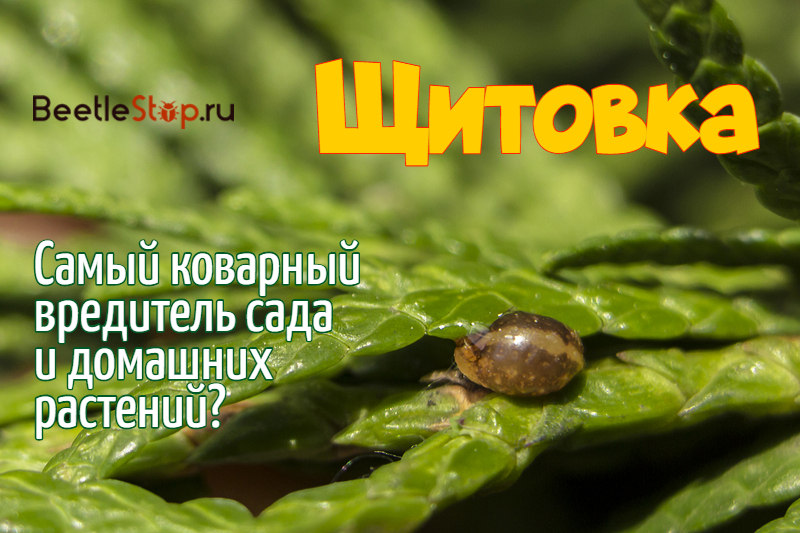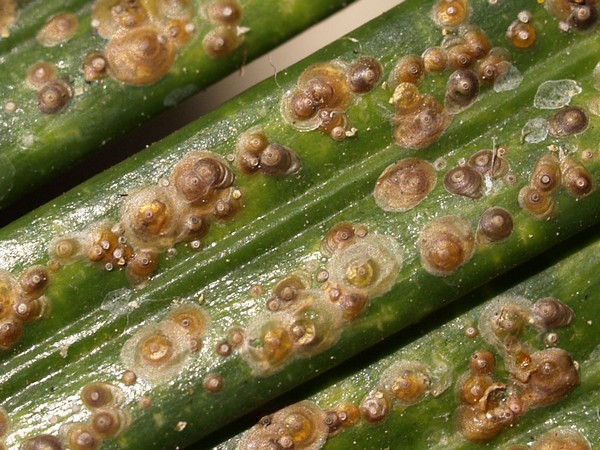How to determine that a dangerous pest has appeared on the plant - scab
Content:

Seeing tiny swellings on the bark of a tree or the trunk of a houseplant, which often resemble an adhering piece of garbage, it is difficult for an ignorant person to recognize insects in them. But this may be the most ordinary and very dangerous scale insect - a representative of the suborder Koktsid. The effects of parasitism are manifested by a weakening of the culture, the appearance of characteristic defects, and in the case of severe infection and death of the plant.
On a note! Due to the ability to mimic, remain undetected for a long time, live in numerous colonies, scale insects are considered the most insidious and dangerous pests of garden, forest and ornamental crops.
Biological portrait of scale insects
Entomologists know about 2400 species of scale insects. In nature, false shields are also found. In the latter, the shield is a part of the body and does not separate from it. If you try to take the scabbard in your hands, then the wax shell will easily detach from the insect. Another sure way to sift out all doubts, whether it is a scabbard or a false scabbard, is to examine an individual under a microscope. The presence on the flap of the eyes is a sure sign that in front of you representative of false shields.
Appearance
Recognizing pests, even despite the abundance of species, it is possible by specific characteristics inherent only to these insects.
- the length of the body of the female does not exceed 1.5 mm;
- its shape can be either oval or round;
- the female has no wings, legs;
- there is no clear separation on the head, the abdomen looks like a monolithic plaque, in some species the eyes are reduced;
- color from light white to brown, saturated dark violet;
- the scutellum consists of two larval skins, easily separated from the body;
- the sucking oral apparatus is represented by one or three-segmented lip, proboscis and setae.
The male is inferior to the female in size. But it has a pair of wings, antennae and legs. In most species, the oral apparatus in males is absent. And there are also such varieties in which there are simply no males and females breed parogenetically.

The eggs are tiny. Shape and color are determined by species.
Interesting! Larvae of the first age are originally called strollers. They have 6 legs, tail setae, developed antennae, a sheet of eyes and a proboscis folded in the form of a pocket. The size of juveniles is 0.4-0.5 mm. As they grow older, they lose part of their organs and mobility.
Features of life and reproduction
Most scale insects lay their eggs, but there are also live-bearing species. Young larvae that were born are very mobile, for which they received the name of tramps. Having got out from under the shield, they settle on the plant, most often on the same one on which they spawned. Under natural conditions, immature individuals are often carried by the wind over long distances, washed away by rain. A significant part of the tramps in this case dies.Surviving individuals are housed at a new facility and begin feeding.
Scale insects live in colonies, causing serious damage to the plant. Sucking to trunks, shoots, leaves, absorb nutrient juices. In these places, peculiar growths are formed, curvature caused by cell hypertrophy.
In the female larva, legs, antennae, and often eyes, are reduced during the growth process. Oral organs, in contrast, develop. The vagabond undergoes 2-3 molts. Unlike most insects, the scabbard does not discard the old cover, but continues to wear it on itself, which subsequently forms a strong shield.
The male larva secrete a wax-like substance that forms a carapace above the body. Young males of the second age do not eat anything, lose their mouth organ, limbs. During this period, they are not distinguished by special motor activity and are more reminiscent of pupae. Instead of lost organs, legs and fore wings are formed.
Interesting! The life of an adult male scalefish lasts only 1-3 days. After the fertilization of the female, he dies. The role of “inseminators” in this family is insignificant, as females are able to breed without the participation of males.
The number of generations per year is different. In household plots in the European zone, one generation usually develops. In subtropical regions, greenhouses, indoor plants, scale insects produce more offspring.
The number of females and males in the population varies each year. This is due to living conditions. When favorable, more females are born. With an insufficient food base, negative climatic conditions, a massive appearance of males is noted.
Variety of shields
Types of scale insects differ in color, gastronomic preferences, habitats. All of them harm the plants on which they settled. Consider the most common of them:
- California scale insect - a multinucleated pest is recognized as a quarantine object. It settles on almost all fruit stone trees; Apple tree, cherries, cherries, pears. He often looks in the rose garden. Larvae hibernate, hiding under the bark of trees. Viviparous females are extremely fertile and can give life to 590 individuals. The body color is represented by a tan palette.
- White scale shield, she mulberry. Both females and males are covered with a white shell. In terms of harmfulness and prevalence, they are second only to the California species. Heat-loving insect, most of all causes trouble in Turkey, Greece, Hungary. It mainly harms stone fruit, mulberry, tea plantations. But it may well migrate and spread with planting material or fruit.
- Red pear scale, in accordance with its name, prefers pear trees. Also found on hawthorn, dogwood, walnuts, barberry. Fertilized females overwinter, which, with the onset of heat during the flowering of pears, begin to lay eggs. Having laid off 40-50 embryos, females die off.
On a note! Scars are very harmful to tree development. On the affected areas, notches, depressions form, growths form. Long-term infection leads to the complete death of the tree.
- The yellow pear scale causes serious damage to the fruits, which appear purple spots. Pest colonies are rarely found on leaf blades. Most often live on trunks, branches.
- Speaking about the types of scale insects, one cannot but mention the apple-tree spot-like variety. The omnivorous pest is simply amazing: ornamental plants, fruit, berry, stone fruits, tree species of trees. A characteristic feature of the insect is a shape resembling a comma. The color depends on the feed plant. Most often, the female has brown, brown shades. The dimensions of the shield are quite overall and reach 3 m in length. The male is more colorful - a red-gray color, but the carapace is half that of a female.
Females are quite fertile and lay up to 100 eggs. Eggs hibernate under the parental shield and die only if the thermometer drops below the minus 40 ° C. Populating the tree with numerous colonies, scale insects cover it almost completely. Which leads to a lag in growth, development, reduction of commodity and quality characteristics of fruits.
Pests on indoor plants
Scaffolds on indoor flowers are represented by a wide variety of species, among them cactus, brown, laurel, olive, palm. The latter species affects orchid, ornamental palm trees and other tropical plants that are grown at home.
The reasons for the appearance of scabies on indoor plants are very diverse:
- Acquisition of an infected plant. If it had eggs of a scale insect and larvae were born, they could freely migrate to nearby plantations.
On a note! All new items purchased must be quarantined for two weeks. Such a measure will protect other plants from a large number of pests, which can be potentially infected with a "newbie".
- It is impossible to exclude the possibility of penetration of guards through the window or while staying on the balcony, suburban area. Young larvae often spread by wind.
- Weakness of the "green" friend, improper metabolism, lack of moisture, light, excess nitrogen make the plant vulnerable to pests.
On a note! The following symptoms indicate that the scabies settled on indoor flowers: the leaves become sticky due to the secretions of the scabies, the affected fragments turn yellow, spots appear on them, a yellowish coating. On stems, shoots tubercles, growths are formed.
What are the dangerous shields for indoor plants:
- The sweet span secreted by scale insects provokes the development of soot fungus and other pathogenic bacteria.
- The plant loses its decorative properties. The appearance of yellow plaque makes them unsightly.
- By sucking nutrient juices, pests weaken the plant. Affected areas are deformed. In the end, it may even die.
How to deal with scale insects at home
The method of treatment of green space depends on the degree of infection, the condition of the flower. Of course, the fastest way is to use insecticides. But it is only reasonable to resort to it when the colony of scale insects has reached impressive size. In addition, a durable shield protects pests from chemical preparations.
To save the home planta number of activities should be carried out:
- First of all, the diseased plant must be isolated from the rest and a visual inspection is carried out to identify the scutellum of nearby flowers. The window sill must be washed with disinfectants.
- Heavily infected shoots, sheets are subject to pruning.
- It is advisable to replace the top layer of the substrate.
- Using a cotton swab, toothbrush, or small sponge, gently remove all insects. To facilitate the procedure, use an alcohol solution. To prepare it, you will need 10 ml of alcohol, 10-15 ml of liquid tar soap, 1 liter of water at room temperature. The mechanical collection with a soap-alcohol solution is repeated after 7 days.
On a note! Before proceeding with the processing of the plant, a test should be conducted on the susceptibility of the flower to the components. For this, one leaf is processed and the state of the plantation is monitored during the day.
- After processing, the plant is rinsed with warm water and dried from excess moisture during the day.
- When all the moisture has evaporated, to consolidate the result, you can spray the flower with an insecticide, for example, Aktara, Mospilan, Inta-Vir, Bankol. When choosing a remedy, care should be taken to ensure that it has a systemic or intestinal effect. Processing is carried out in accordance with the instructions.
- The use of certain drugs involves the removal of the plant into an open, ventilated area.In some cases, the treated flower is covered with a bag for 15 minutes. After this time, the green "pet" is washed under a stream of water to remove dead shields and chemical components.
The full cycle of procedures is repeated after 7-10 days, as the scabies could hide in the axils of the leaves.


 (votes: 9, average rating: 4,78 out of 5)
(votes: 9, average rating: 4,78 out of 5)